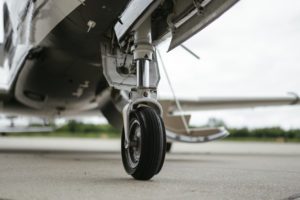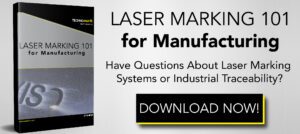Direct Part Marking 101: Aerospace Part Marking Considerations
Aircraft have an expected lifespan of roughly 20 years. During that time, the components involved in the operation of the aircraft are regularly exposed to high temperatures. This means the part marking system used for aerospace applications must withstand these conditions, allowing the part to be identified as easily at the end of its lifespan as at the beginning.
Direct part marking is a method employed by manufacturers to streamline the process of identifying parts reliably. The mark must be durable, withstand specific conditions, and be unique to facilitate the identification process. Aerospace part marking in particular requires methods that withstand high temperatures and maintain readability.
What is Direct Part Marking (DPM)?
Direct part marking (DPM) is a system of tracking products using 2D codes marked directly on the part. This better facilitates the part’s identification throughout the manufacturing and supply chain journey.
DPM has grown in popularity with the U.S, Department of Defense, as well as within the automotive, aerospace, medical device, and electronics manufacturing spheres. The DPM process provides improved quality of marks and also traceability over time. Safety and liability concerns, as well as warranty issues, are improved through the use of DPM. Likewise, the occurrence of data entry errors is reduced through the utilization of this process.
Ink, Dot Peen, and Chemical Etching: Why They Aren’t Ideal
Various DPM methods exist and are still reliable means to the end of tracing parts throughout their lifespan. However, with the aerospace industry’s unique challenges and high expectations for components of an aircraft, the more traditional part marking methods are less effective.
Inkjet and Radio Frequency Identification (RFID) part marking processes are effective in many scenarios, but due to the high heat exposure, they are not ideal for aerospace applications. There is also the additional cost of ink supplies to consider with the inkjet method.
Likewise, chemical etching requires additional funds for supplies, and there is waste created during the marking process.
Dot peen raises concerns regarding repair when it becomes necessary, and the marks created by this process also can be more challenging to read for a high-definition, high-speed device.
How Laser Marking Resolves Issues for Aerospace Industry Applications
Laser marking improves part traceability, which is key to the process of both aircraft manufacturing and maintenance. The process allows manufacturers to mark each component and not worry about damage or distortion due to the marking process.
The laser marking process does not require contact with the part. Therefore, the marks created are permanent and durable, all without risking damage or any alteration to the parts themselves.
Laser marking is an energy-efficient and affordable part marking method that reduces the environmental impact. The process can be used on aluminum, titanium, or stainless steel – all without any type of consumable component necessary.
Some of the attractive qualities of laser marking are
- Speed
- Flexibility
- Simplicity to complete
It also is a reliable way to enhance traceability and repeat the process for each part. The software controlling laser marking makes it more streamlined and reduces operator involvement. This way, part numbers, and bar codes are both created consistently, and both cycle time and overall productivity are increased.
Some of the materials used for parts for aircraft require laser marking to be both effective and non-damaging. The laser marking process is also easily automated, increasing the volume of products produced within a specified timeframe.
Check out the video of our partner below for an idea of how laser marking works:
 Aerospace Part Marking Involves Time-Saving Software
Aerospace Part Marking Involves Time-Saving Software
Today’s technology provides increased accuracy and reliability. The process also improves consistency and cuts down on the risk of human error. The software involved in the laser marking process generates serial numbers, further improving the accuracy and reliability of the manufacturing process.
Strict regulatory standards for the aerospace industry require a reliable and unmistakable part marking method. Aerospace part marking requires methods such as laser marking to provide that reliability and clarity.
Time and Traceability in Aerospace Part Marking
The two-decade lifespan of an aircraft means that all the components involved in the manufacture of the vehicle must be clearly marked with a method that will be effective for the long term. The use of DPM, specifically laser marking in recent years, has improved the traceability of parts and also the later life span identification process. Laser marking is a widely accepted method of part marking that facilitates further improvements in the aerospace industry.
Consult the Experts: Technomark Can Help
Our Technomark professionals can help you determine the best DPM solution for your product line. Reach out to discuss your needs with us.



